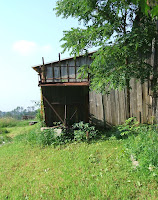The second Sunday in July is designated “barn day,” when the importance of barns in the farming communities in the United States is observed. Barns are historically the center of the farm, built to accommodate animals, grain, hay, and equipment. The word barn originates from the Old English word for ‘bere,’ or barely, and ‘aem,’ which means storage space.
Throughout our lands, there are many different types and styles of barns, built and designed to reflect the type of farming that occurred there. In northeastern Pennsylvania, where I grew up, our dairy barn was a bank barn which meant it was built into a bank allowing for easy ground access to both the upper and lower floors. The upper floors accommodated haylofts where first loose hay and then baled hay were stored for the cattle housed on the lower floor.
Most barns in northeastern Pennsylvania were constructed of hemlock, a very hardy wood which seasons to a light gray color. The eastern hemlock is the state tree of Pennsylvania and large, plentiful stands existed in the 1800s.
By design, our barn was fashioned after a design called the Dutch Barn with its hip or gambrel roof which had two symmetrical slopes on two sides, with the lower slope steeper than the upper one. However, the barn itself was more rectangular, like the English and German barns, and the broad expansive side had wide doors on tracks that opened and allowed for wagons to enter directly into hay loft, making unloading the hay load easier.How did they get the hay into the barn? A long rail or
track ran along the inside length of the roof, from peak to peak, and
accommodated a double harpoon hay fork, pulleys, and trip rope. Once the fork,
with its two giant tines, was secured into a bundle of hay, a horse—and later a
tractor—pulled the stack of hay up and onto the track. After delivering it to
the proper location, a yank on an attached rope would trip the hay fork to release
its load. I often worked the mow. Using a pitch fork, I dragged layers of hay
to the far corner and edges of the loft to even it out.
So what do you do on Barn Day? Why not take a ride in the country and go looking for old barns? They are a disappearing structure on our rural landscape as the farming industry has slowly faded over the years and the barn buildings have gone to disrepair.
Visit my Amazon Author Page for all my books






